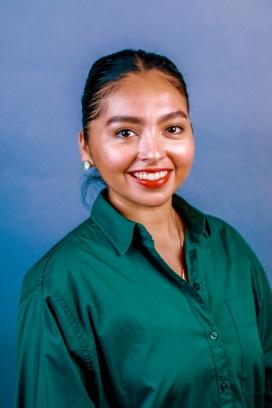Meet Revise: Valeria Alderete
We are excited to share our interview with Valeria Alderete, the Content & Communications Coordinator for the REVISE team.
"I see parallels between my past experiences and the potential application in the realm of informal science education (ISE). The lessons learned in bridging divides between cultural heritage and seemingly unrelated organizations can be harnessed to foster more culturally responsive, accessible, and meaningful experiences in ISE."

What are you most excited about or looking forward to accomplishing while working on REVISE?
Working with the REVISE Center represents many exciting opportunities to shift narratives and ideas surrounding who is represented in the informal STEM education (ISE) field and who ISE–and STEM at large–is for. I am most excited to empower people from historically marginalized communities to challenge ideas and systems that have created inaccessibility and inequities in ISE.
The opportunity to help develop tools and resources for community members to learn about and implement equity-focused practices in their own spaces and work fuels my enthusiasm, and to do so alongside individuals who bring their diverse experiences and expertise to this and who share a commitment to advancing equity in ISE is incredibly motivating. I look forward to co-developing resources that guide organizations not only in identifying but in addressing systemic disparities, promoting diversity, and ensuring equitable access to their research and projects.
For me, this also represents an exciting opportunity to draw on my own perspective as an information design and communications professional and experiences as a Latina, Chicana in STEM to help foster inclusive, welcoming, and equitable spaces and conversations within the ISE field. I also embrace the challenges that this work will bring—continuous self-reflection, decentering oneself, and a thoughtful examination of power dynamics. I recognize the importance of incorporating these considerations in developing resources with and for members of the most disenfranchised groups and welcoming and amplifying those perspectives to inform this work.
What do your current partnerships look like?
My background is rooted in working and collaborating with community-based organizations (CBO), particularly those rooted in arts, culture, and cultural heritage. I worked with a small CBO that focused on preserving and perpetuating a music that is native to the South Texas and Northern Mexico region for several years. The work revealed unexpected partnerships between seemingly disparate organizations such as senior centers and [military] veteran organizations as it became evident that the music programming had positive impacts on aging and veteran communities. These collaborations were transformative, underscoring the potential of interdisciplinary connections to bridge gaps between informal music education and local senior centers and veteran communities.
I see parallels between my past experiences and the potential application in the realm of ISE. The lessons learned in bridging divides between cultural heritage and seemingly unrelated organizations can be harnessed to foster more culturally responsive, accessible, and meaningful experiences in ISE. By integrating ISE concepts into cultural contexts, we have the opportunity to create programs that resonate with diverse communities, breaking down barriers and making learning not just educational but deeply ingrained in the fabric of people's lives.

How do you engage community members?
My approach to engaging community members seeks to always be grounded in accessibility, inclusivity, cultural relevance, and participatory design. Past experiences have shown me the power of participatory events in building connections. For example, hosting workshops and events that encourage active participation offered spaces for personal connections and fostered a sense of belonging, curiosity, and shared knowledge.
Similarly, utilizing digital platforms as spaces for discussions, resource-sharing, and engagement has extended the reach of our initiatives beyond geographical constraints, ensuring accessibility to a broader audience. Seeking continuous feedback is another community engagement method that has proven particularly essential in refining strategies. This iterative process ensures that our efforts are not only impactful but also responsive to the evolving needs of the community, adapting to their unique cultural contexts.
In essence, I see many parallels in the community engagement approaches I’ve used in the past, although initially developed in the realms of arts, culture, and cultural heritage work. The approaches illustrate how principles of inclusivity, cultural relevance, and participatory design can effectively guide community engagement in REVISE’s work within ISE as well as other fields of work.
What do you envision the role of the REVISE center to be in the informal science community?
I envision the REVISE center being an accessible hub for ISE organizations and practitioners to learn about and implement equity-centered approaches in their research, evaluations, work and spaces. While the Center will act as a library of informational material and resources surrounding equity-focused practices, the Center will also provide actual strategies and frameworks to put theory into practice, equipping organizations to disrupt patterns of inequity and expand to meet the needs of diverse communities. I also see REVISE as a catalyst for ongoing reflection and improvement within ISE and a space to reimagine how we engage with and think about ISE, especially surrounding who is represented in the field.